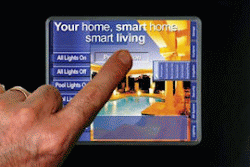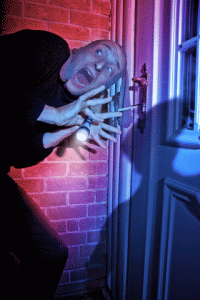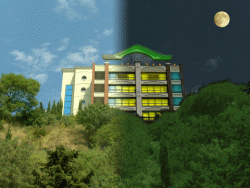Light Control Systems: Switches, Dimmers and Sensors for Setting Lighting Levels
Light control systems provide both practical and aesthetics lighting options.
One of the most exciting recent developments in lighting design is sophisticated light control systems. Until twenty years ago, all that was readily available to home owners was the light switch, some basic dimmers that could be moved by hand and some inflexible timers. Today, there is a much wider range of lighting control options.
What makes this wide range of options so exciting for lighting design is that you can actually now set up multiple lighting plans for individual rooms, without individually manipulating each light fixture. For example, you could have light levels in your dining room for meals during the day, guest dinners at night, family dinners at night and romantic dinners at sunset. You could even add a setting for cleaning up. Light control systems allow you to do all of this and more.
Practical Uses of Lighting Control

Many lighting systems are controlled from control panels around the house, or even a cell phone.
In this section, I will discuss some of the uses light control systems, including a number of tricks for getting the most out of those systems. Light control can be used for safety, for security, for transitions between day and night and for providing rooms with different usage options.
Motion Detection
Light control systems provide a number of options for both safety and security. In terms of safety, one important option is the motion sensor light switch. Motion sensor light switches are able to tell when someone has moved within a given location, and they then turn on a light at some level or other. While they have been available for a while, their price has recently dropped significantly.
There are a number of different possible uses for a motion sensor light switch. They can be used for your own safety in hallways and in bathrooms. Rather than stumble about in the dark, a dim light can be turned on that allows you to move about safely. Of course, this can be done for convenience as well as safety, turning on a light for you so that you don’t need to fumble for the switch yourself.
Security Lights

Many thieves are so afraid of being caught, even the simple turning on of lights is enough to dissuade them.
Lighting control gives you more security as well. Security lights may also use motion sensor light switches, turning on bright lights whenever they sense that someone is passing by outside. Of course, if you do wish to use such lighting, you should make sure that you can turn it off when you don’t want your guests being blasted by bright security lighting when they are in your backyard.
You can also use some of the more sophisticated forms of lighting control to create the impression that you are at home. Centralized lighting control can be put on a light switch timer, turning lights on for periods during the evening to make it appear that you are at home. You can even make it look like you are reading in the living room, head to the kitchen for a snack, then go to your bedroom, just by using some centralized lighting controls.
Turning All Lights Off
One of the other advantages of modern light control systems is the ability to turn off all of the lights in a room or even in a home at the same time. Single rooms often use what is called a “half-hot” plug. These are plugs where the power to a plug or plugs can be turned off from a central switch on the wall. In this way, you can turn off all of the lights in the room when you leave, and turn them back on by flipping a single switch. You can plan the connections between your switches and light sources using a light switch diagram.

The Clapper may be familiar to you from late night television, but they are horrible for light control. If you ever make a loud sound, you’ll also turn the lights out.
Just be sure to clearly mark “on” and “off” on your switch. Nothing is more annoying than thinking you are turning on a lamp, realizing the switch is off, turning on the switch, realizing you just turned off the lamp, and finally turning the lamp on again. So much for saving time! Safety warning: “Half-hot” plugs may never be dimmed. If you were to plug an appliance into a dimmed plug, you could start a fire.
Another option for turning off all of the lights is to turn off all of the lights in the home when you leave from a single light switch by your front door or garage door. This requires some set up, of course. You will need some way for the controls at the front door to communicate with the controls in your individual rooms. Many new homes are being built as “smart homes”, in which all of the panels in the home communicate through wires. However, you can set up a similar system using a remote control light switch, as well. The control panel at the front door may communicate with the control panels of all of the other rooms.
Aesthetic Uses of Lighting Control
Most of what I have mentioned so far has been examples from safety, security or convenience. Of course, the ability to manage light control systems also has many applications in aesthetic lighting design, the quality of light and how it affects your mood. The greatest benefit that modern light control systems provide is that they allow us to have multiple arrangements of our lighting levels that we can use for different circumstances.

Sunlight makes such a difference to a room’s light, that it is helpful to have at least two lighting plans per room.
Let’s use a simple example. You wish to use your living room for two different things. First, you want to use it during the day for reading and casual family conversation. Second, you want to use it in the evening for entertaining. How can light control systems contribute to the lighting of this room?
During the day, you notice that your large, southern-facing window brings a lot of light into the room. Therefore, there’s really no reason to light that area of the room very well. Set the recessed lighting there to its lowest level. In the northern end of the room, the area looks a little dark because southern light is so strong. So, you brighten the recessed lighting fixtures there and increase the light for the accents.
During the evening, when you have guests, you decide want to provide a nice contrast between your accent lighting and your ambient lighting to create drama and intimacy. You turn your accent lighting up to slightly higher than normal levels, and decrease your recessed lighting to slightly lower than normal levels. You then turn on the reading lamps for some added texture.
In each case, you would program in the lighting that you have generated, so that you can easily swap from one lighting plan to the other with a push of the button. For many systems, you can even program in dozens of different plans, each for a different situation.
Putting It All Together
Light control systems provide a number of different options, both practical and aesthetic:
- Light control systems can provide safety and security by giving us light when we need it (and when criminals don’t want it).
- Lighting control can control many lights from a single location, increasing our convenience.
- Lighting control allows us to have numerous lighting plans for a single room, all easily accessed from a single panel.
In fact, it is safe to say that light control systems are the next step in the development of home lighting design.
More Light Control Articles:
Motion Sensor Light Switch: Motion Detection for Safety and Convenience
A motion sensor light switch can enhance your lighting outdoors, indoors and in between.
Remote Control Light Switch: Flexible, Wireless Control
A remote control light switch enables you to avoid expensive installation costs for new wiring.
Light Switch Diagram: Circuits for Planning Electrical Paths
A light switch diagram helps you plan the paths electrical current will take in your room.
Light Switch Timer: Managing Phases of Light
A light switch timer allows you to vary your lighting depending on the time of day.